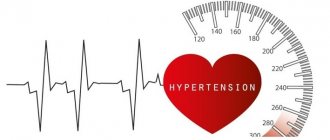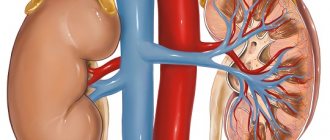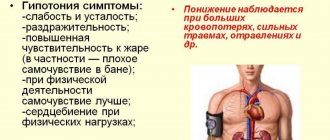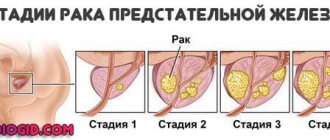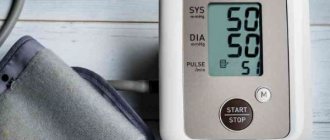The blood pressure value is expressed in two numbers. The first indicator is systolic pressure, which is popularly called upper, the second is diastolic, or lower. Systolic shows the level of blood pressure when the heart contracts, diastolic - at the moment of its relaxation.
Normally, blood pressure should not exceed 120/80 mm Hg. pillar If it is between 120/80 and 139/89, we are talking about prehypertension, higher values indicate hypertension, or hypertension. Most often, with elevated blood pressure, both indicators exceed the norm. A more rare occurrence is high lower blood pressure with normal upper blood pressure.
What is diastolic pressure?
It means the degree of blood pressure on the vascular walls at the moment of relaxation of the heart muscle, when there is little blood in it. This indicator gives an idea of the tone of the vascular walls, since diastolic pressure is a reaction to their resistance. Lower blood pressure is considered normal if it is below 80 mm Hg. pillar
A sustained increase in diastolic blood pressure indicates a high resistance of the vascular walls, which means their constant spasm. If the vessels are always narrowed, blood flows poorly to the organs and tissues and they do not receive enough oxygen and nutrients. This leads to disruption of organ function.
There are three stages of isolated increase in lower blood pressure:
- 1st – 90-100 mm Hg. Art.;
- 2nd – 100-110;
- 3rd - above 110.
Diagnostics
Increased diastolic pressure is not an independent disease, but develops as a symptom of one or another pathology of the internal organs or endocrine system. Therefore, if an increased lower blood pressure is repeatedly noted, the patient must undergo a detailed medical examination, including:
- consultations with a therapist, cardiologist, nephrologist and endocrinologist;
- Ultrasound of the abdominal cavity and thyroid gland;
- ECG;
- Echo-CG;
- Dopplerography of cerebral vessels;
- clinical (general) blood and urine analysis;
- determination of the level of thyroid hormones in the blood;
- excretory urography;
- Rehberg's test.
Depending on the results obtained, additional studies of certain organs and systems may be prescribed.
To determine high blood pressure, it is necessary not to measure it once, but to measure it three times
Causes of increased diastolic pressure
Hypertension can be primary, that is, it is unknown why blood pressure has risen, and secondary (symptomatic), if it develops against the background of other diseases. Why does diastolic blood pressure increase?
Causes of isolated increase in lower blood pressure
If lower pressure is elevated for a long time, the reasons may be the following:
- Kidney disorders. The kidneys are one of the main organs involved in regulating blood pressure. The cause of increased diastolic blood pressure may be a narrowing of the renal artery, in which the volume of blood entering the kidneys decreases. An increase in blood pressure with a predominant increase in diastolic is observed in chronic glomerulonephritis, congenital anomalies in the structure of the renal vessels, and renal failure.
- Thyroid diseases.
- Cardiac pathologies: heart defects, tumor processes.
- Diseases of the adrenal glands and pituitary gland.
- Spinal hernias.
- Changes in hormonal balance, for example in women during pregnancy.
The kidneys are directly involved in regulating blood pressure. If their work is disrupted, the pressure deviates from the norm
Reasons for increasing lower blood pressure simultaneously with upper blood pressure
- Increased lower pressure is usually observed in essential hypertension, which is also called essential hypertension (HD) or primary hypertension. The reasons for the increase in pressure in this case have not been established and it is in no way related to other pathologies. Hypertension with high diastolic pressure is more often observed in young people and can progress and take a malignant course. With this disease there is a high probability of developing complications, and the higher the pressure, the greater the risk.
- Lower pressure can change throughout the day in healthy people, for example, it can increase during emotional or physical stress. As a rule, it quickly decreases on its own, and this is considered normal.
- Excessive alcohol consumption.
Lower pressure 90 - is this normal?
Every person should have a blood pressure monitor in their first aid kit. If there is no one in the family who could manually inflate the cuff with a bulb and determine the pressure parameters by the movement of the arrow, you can buy an automatic device. It is not much more expensive, and in addition to pressure, it also counts the pulse and can determine signs of arrhythmia. Feeling unwell for no apparent reason should be a reason to measure your blood pressure.
The optimal indicators are considered to be a pair of systolic and diastolic pressures of 120/70 Hg, but even if these numbers rise to 130/80 Hg, this will be considered normal. Values of 140/90 Hg and above are considered elevated. With these values, the doctor can already diagnose arterial hypertension and prescribe a course of treatment.
A lower pressure of 90 units indicates the onset of hypertension. Such values can also appear at a young age, so not only older people need to monitor their blood pressure. Young people have a higher tendency to identify chronic pathologies, which are often accompanied by associated complications.
Danger
An increase in lower pressure often has no symptoms, and a person does not even know about it. They may be discovered during a routine examination or when visiting a doctor for other reasons. There is a misconception that only elevated upper blood pressure threatens health and life, but in fact, an increase in lower blood pressure is no less dangerous. The heart in this state is constantly tense and practically does not relax. The blood flow in it is disrupted, the disease progresses, structural changes begin to occur, which ultimately become irreversible.
It is important to know that high lower blood pressure cannot be ignored. It leads to organ dysfunction and, without treatment, can result in death within six months. There is a high risk of developing thrombosis, heart attacks, and strokes.
How to influence blood pressure levels?
It is a generally accepted fact that it is possible to normalize blood pressure numbers without medications and surgeries. However, this should be done in the early stages of arterial hypertension. The treatment program consists of giving up bad habits, reducing body weight to normal, following a diet with a predominance of vegetable fats over animal fats, limiting table salt and an active lifestyle.
If these measures are ineffective and in advanced cases of hypertension, antihypertensive drug therapy is prescribed.
Physiotherapy exercises, massage, and taking adaptogens and products containing caffeine help hypotensive patients to slightly increase their blood pressure and vitality. Salty foods can have a slight effect on the level of diastolic pressure due to fluid retention in the body and an increase in the volume of circulating blood.
Expert: Natalya Dolgopolova, general practitioner
Author: Tamara Mutnovskaya
The material uses photographs belonging to shutterstock.com
Treatment
Treatment should be carried out only under the supervision of a doctor. You should not do this yourself. First of all, you need to find out the reasons for the increase in lower blood pressure. If hypertension is secondary, treatment of the primary pathology is required. In any case, it is necessary to reduce the pressure, for which a set of measures is used, including:
- proper nutrition;
- loss of excess weight (if any);
- compliance with the daily routine (work and rest);
- physical activity (sports, physical therapy, walking);
- staying in the fresh air;
- taking medications;
- folk remedies.
Diet
Proper nutrition is of great importance for normalizing blood pressure. The diet should consist of:
- Fresh vegetables, herbs, berries and fruits.
- Lean meats.
- Dairy and fermented milk products.
- Lean fish.
- Bread made from wholemeal flour.
- Replace sugar with honey.
The following foods should be limited or avoided:
- salty (salt retains fluid in the body, which increases blood pressure);
- fatty and fried;
- sweet and buttery;
- alcoholic drinks.
All people with hypertension should limit salt in their diet
Medicines
You should only take medications prescribed by your doctor. Typically, medications from several groups are used to normalize blood pressure, including:
- Beta blockers are drugs that reduce the heart's need for oxygen, regulate its functioning and lower blood pressure.
- Calcium antagonists - increase the activity of renin, which is poorly produced in renal pathologies. Prescribed in severe stages of hypertension, for example, in renal failure, after heart attacks to prevent death.
- Diuretics (diuretics).
Traditional methods
Traditional medicine offers many remedies to lower diastolic blood pressure, but they should only be taken with the permission of a doctor. As a rule, these are decoctions and infusions that reduce nervous tension, help you relax and calm down.
Hawthorn
An infusion of the fruits of this plant relaxes vascular walls and relieves nervous excitability. A glass of water will require 20 grams of dry fruits. Boil for 30 minutes, then strain and add water to the original volume. Take a tablespoon three times a day.
Traditional medicine suggests treating hypertension with a decoction of hawthorn fruits
Motherwort
The infusion increases the strength of heart contractions, calms the nerves, and eliminates overexcitation. Two tables. Pour a spoonful of herbs into a glass of hot water and leave for an hour. Drink two per table. spoons every day before bed.
Diuretic collection
Pour a mixture of herbs (a tablespoon each of St. John's wort, oregano, motherwort and sage) with boiling water (two glasses) and leave for half an hour. Drink half a glass a day for a month.
Valerian
It has a relaxing effect on the central nervous system and helps lower blood pressure.
Peony
Pharmacy tincture from herbs and peony roots eliminates muscle spasms and has a calming effect.
Cedar cones
Tincture of pine cones helps lower blood pressure. To prepare, you need to take three whole cones, put them in a glass jar and fill them with vodka (1/2 liter), add ten pieces of sugar, a tablespoon of valerian tincture purchased at the pharmacy and leave for 10 days in a dark place. Strain and drink a tablespoon before bed. You can fill the cones two more times.
Beet
Freshly squeezed beet juice strengthens vascular walls and is used to lower blood pressure. You need to take two teaspoons of juice daily half an hour before meals.
from May 14 to 24 as part of the Year of the Heart at the City Hospital No. 1
them. G.I. Drobyshev hosts an informational and practical campaign
“Learn to control your blood pressure.”
One of the most common health complaints and one of the most “favorite” diseases among older people is increased blood pressure. This pathology can explain any changes in well-being, bad mood and other troubles. Blood pressure can rise and fall several times during one day, and a person’s normal blood pressure is a purely individual concept.
What is blood pressure and what indicators are considered normal?
Blood pressure is a general concept that determines the force with which blood presses on the walls of blood vessels; it would be more correct to call it blood pressure, because pressure matters not only in the arteries, but also in the veins and capillaries. But it is only possible to measure pressure in large vessels located on the surface of the body—in the arteries—without the help of special instruments.
Blood pressure - blood pressure - depends on the speed and force with which a person’s heart contracts, how much blood it can pump in one minute, on the properties of the blood itself and the resistance of the walls of blood vessels.
Factors influencing blood pressure:
- the ability of the heart to contract with sufficient force and ensure normal release of blood through the vessels;
- from the rheological properties of the blood - the “thicker” the blood, the more difficult it is to move through the vessels; diseases such as diabetes mellitus, increased coagulability, greatly impede the flow of blood and can lead to problems with blood pressure; with thick blood, some doctors prescribe treatment with leeches;
- elasticity of the walls of blood vessels - blood vessels wear out over time and cannot withstand increased load - this becomes the cause of the development of hypertension in older people,
- atherosclerotic changes - reduce the elasticity of the walls;
- sharp narrowing or dilation of blood vessels - as a result of nervous shocks or hormonal changes, a sharp narrowing or dilation of blood vessels is possible - for example, with fear, anger or other strong emotions;
- diseases of the endocrine glands.
Normal blood pressure is determined by a combination of a large number of parameters, and for each age, gender and for an individual person, its indicators can vary greatly. Medical standards are taken as average values from healthy people of a certain age. It has long been proven that blood pressure of 120/80 cannot and should not be considered the ideal norm for people of different ages.
To find out what normal blood pressure a person should have at different age periods, you can use the following table.
Blood pressure indicators for an adult:
- Normal blood pressure is considered to be between 110\70 and 130\85 mm. rt. Art.
- Low normal pressure – 110\70 – 100\60;
- Low blood pressure – hypotension – below 100\60;
- Increased normal pressure – 130\85-139\89;
- High blood pressure - hypertension - more than 140\90 mm. rt. Art.
Indicators of normal blood pressure for different age periods:
- 16 – 20 years – 100\70 – 120\80 mm. rt. Art.
- 20 – 40 years – 120\70-130\80;
- 40 -60 – up to 140\90;
- over 60 years old – up to 150\90 mm. rt. Art.
From the table above, it is clear that the older a person is, the higher the normal blood pressure indicators; this is due to age-related changes in blood vessels, in the heart muscle and in other organs. High blood pressure, like low blood pressure, can cause various health problems, but in order to determine whether changes in blood pressure are to blame for poor health, you need to measure it regularly and keep a special diary. For this, several trips to the clinic or visits to the doctor are not enough; only daily regular blood pressure measurements can give correct results.
Measurement.
The correct diagnosis and prescription of treatment largely depends on the correct measurement of blood pressure, because the doctor, when prescribing medicine or prescribing treatment, is largely guided by the measurement numbers.
Today there are different ways to measure pressure:
- The simplest and oldest - using a cuff and a tonometer - here it is of great importance to correctly apply the cuff, the ability to use a tonometer and listen to heart sounds. This measurement requires special training and skills, but when used correctly, it gives fairly accurate and reliable results.
- Electrotonometer - the operating principle is the same, but the results are visible on a special display. This makes it easier to measure your blood pressure yourself and provides more accurate results. But such blood pressure monitors often break down and may show incorrect numbers.
Regardless of the method used to measure blood pressure, several general rules must be followed:
- before the measurement, half an hour before the start, avoid physical activity, nervous tension, smoking, eating, and so on,
- relax, sit comfortably when measuring,
- the posture should be comfortable, the back should be straight, there must be support, the hand should rest freely at the level of the patient’s chest,
- you cannot talk or move during the measurement,
- The measurement should be carried out on both hands and it is advisable to carry out a series of measurements with an interval of 5-10 minutes.
If, after correctly measuring blood pressure, the readings are very different from the norm, you need to repeat the measurements within a few days and, if confirmed, consult a doctor.
High blood pressure.
Considered one of the most dangerous diseases of mankind, hypertension affects about 25% of people worldwide, and this figure continues to increase. Hypertension is an increase in blood pressure above 140/90 mmHg. rt. Art. Causes of hypertension can be:
- overweight,
- genetic predisposition,
- diseases of internal organs,
- lack of physical activity,
- smoking and drinking alcohol,
- excessive consumption of table salt,
- nervous tension,
- other factors.
With hypertension, the patient suffers from headaches (and here pills for headaches will not help), shortness of breath, heart pain, increased fatigue, insomnia, poor health and other symptoms. In addition, the risk of developing cardiovascular diseases, brain damage, pathology of the urinary system and eye diseases increases.
Treatment of hypertension is a very complex and time-consuming process, where the outcome of the disease depends on compliance with the doctor’s recommendations. It is important to find the cause of the increase in pressure and act on it. At the same time providing symptomatic treatment. In each specific case, medications, doses and their combinations must be selected individually by the attending physician.
Without timely treatment or uncontrolled use of medications, hypertension can not only seriously damage health, but also cause a life-threatening condition such as hypertensive crisis.
Hypertensive crisis.
Hypertensive crisis is a life-threatening condition caused by a sharp increase in blood pressure and damage to the nervous system and target organs. Blood pressure figures during a hypertensive crisis can vary greatly in different patients - some people normally tolerate 200\150 mm. rt. st, and for some people feel bad already at 150\85 mm. rt. Art. The nature of the lesions in GC depends on which organs previously had the pathology - if the heart hurts, myocardial infarction may occur, if you suffer from headaches, then a stroke, and so on.
The causes of GC may be:
- psycho-emotional stress,
- exercise stress,
- meteorological changes,
- drinking alcohol,
- rich foods high in salt,
- incorrectly selected antihypertensive drugs,
- diseases of the endocrine system and internal organs.
With the development of GC, the patient’s well-being sharply worsens, a feeling of fear and anxiety arises, nausea, vomiting, darkness before the eyes, swelling and flushing of the face, chills, tremors of the limbs, fainting, and even coma may appear.
If such symptoms appear, you need to lay the patient on any flat surface with the head of the bed raised and immediately call an ambulance. Before her arrival, try to provide the patient with peace, an influx of fresh air, and get rid of restrictive clothing. If the patient has had hypertension for a long time, then, most likely, he is taking some kind of antihypertensive drug, in this case, before the doctor arrives, you can give the patient the usual dosage.
Hypotension, low blood pressure.
For many people, especially those suffering from hypertension, it seems that lowering blood pressure cannot be a problem, but in fact this is not the case. Constantly low blood pressure can cause no less inconvenience and health problems than hypertension.
The causes of this pathology can be hereditary predisposition, poor nutrition and vitamin deficiency, endocrine diseases, nervous strain, general exhaustion of the body and other problems.
A person suffering from hypotension constantly feels tired, overwhelmed, has difficulty performing daily duties and is emotionally inhibited. In addition, there is a decrease in memory and brain activity, poor thermoregulation, increased sweating, headaches, drowsiness, pain in the joints and muscles, and a general feeling of poor health.
Although, unlike hypertension, hypotension does not cause serious health problems, it also requires treatment. Only a doctor can determine the cause of hypotension and prescribe treatment after a detailed examination. And without medical help, we can advise you to establish a work and rest schedule, eat well, not be nervous and give up bad habits.
Original article https://tibet-medicine.ru/sovrmed/normalnoe-davlenie-cheloveka
Features of pulse pressure
The term refers to the difference between systole and diastole. It shows the patency of blood vessels and the general condition of their internal membranes. The ideal difference between the two values should be 60 mmHg; a larger gap in the data indicates vascular spasm or inflammatory processes occurring in the blood vessels.
A greatly reduced level of pulse blood pressure is considered characteristic of certain pathologies, represented by:
- heart failure;
- stroke in the left ventricle of the heart;
- myocardial infarction.
If deviations from standard sizes within 40-55 units are detected, you must consult a cardiologist. The doctor will issue a referral for a laboratory diagnostic examination, and after clarifying the presumptive diagnosis, he will prescribe therapy in accordance with the detected disease.
Controlling blood pressure is the key to the health of the whole body
Blood pressure is a common name for two indicators: systolic (upper) and diastolic (lower). If any of them goes beyond the normal range, as well as an excessively large or very small difference between the indicators, they can be symptoms of various diseases. In order not to miss the onset of pathology and take timely measures, it is necessary to regularly measure blood pressure and consult a doctor if the measurement results do not correspond to the norm.
Increased systolic pressure
High upper pressure is a sign of:
- Overactive thyroid gland (thyrotoxicosis);
- Severe anemia;
- Bradycardia (decreased heart rate);
- Aortic valve insufficiency;
- Reduced elasticity and increased density of the vascular wall (for example, atherosclerosis of the aorta).
This condition is called isolated systolic hypertension or systolic hypertension. Upper blood pressure often increases during adolescence. This is due to hormonal changes in the body and is not considered a deviation. With the completion of puberty, the indicators return to normal. True, such changes increase the chances of developing hypertension in adulthood.
Treatment of systolic hypertension is generally similar to those taken for normal hypertension. This also applies to prevention. The main thing is to identify the disease in time, regularly monitor your blood pressure and take medications prescribed by your doctor, including those that help lower blood pressure. In addition, you need a diet, adequate physical activity, and protection from stress.
Reduced upper pressure
Low upper pressure may be associated with lifestyle or illness. In the first case, we are talking about constant overwork and systematic stress, lack of sleep and excessive physical activity. As for pathologies, a decrease in systolic pressure is caused by:
- Thyroid diseases, hormonal imbalances;
- Diabetes;
- Vegetovascular dystonia;
- Arrhythmia;
- Heart failure.
The cause may be prolonged depression. In any case, to normalize the pressure, you need to consult a doctor and identify the factors that contributed to the decrease in pressure. Usually the doctor recommends mainly preventive measures such as strong tea, contrast showers, and healthy sleep. But in some cases, drug treatment is required.


